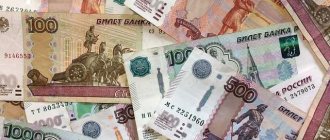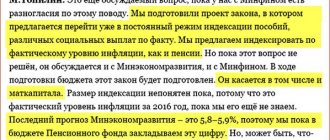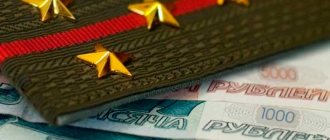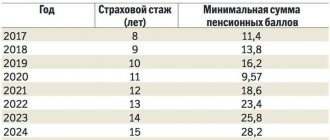The second stage of pension reform is postponed until 2021. The pension system that previously existed in Russia provided for the formation of a funded part of the pension, which consisted of pension transfers. That is, previously 22% of wages were transferred to the Pension Fund, which was divided into two parts: 16% - the insurance part of the pension, and 6% - the funded part. Starting in 2014, this part of the pensions was frozen due to the difficult international situation of Russia and the imposition of sanctions on it
The Government of the Russian Federation plans to further improve the pension system, which consists of abolishing the mandatory funded part. It is planned that citizens themselves will form the funded part of their future pension. These voluntary contributions will range from 1 to 6%, at the discretion of the individual
They will be called IPC - individual pension capital . The IPC is planned to be put into effect in 2021. This part of the pension reform was postponed due to the negative reaction of Russian citizens to raising the retirement age.
It should be noted that the transfer to a new type of deduction will be carried out voluntarily by writing a corresponding application. The previously existing funded part of pensions will be cancelled. There are two ways to offset it if the funded part is in the Pension Fund:
- Conversion of the funded part into points regulating the amount of the insurance pension.
- During the “transition” period, redirect accumulated funds from the Pension Fund to the Non-State Pension Fund to form an individual investment complex.
Russians have prepared a new pension reform for 2020
The head of the Ministry of Finance of the Russian Federation, Anton Siluanov, said that the main event of the year in the country - raising the retirement age - was “tight and difficult.” Because of this, Siluanov noted, the introduction of individual pension capital was slowed down.
The main essence of accumulating individual pension capital is the voluntary donation by Russians of part of their wages, which will go towards future pensions. Many lawyers began to doubt that such a donation would be voluntary. Officials even thought about signing Russians up to this type of tax by default without any agreement from them.
In turn, Russians are not very keen to give away their earned money. After all, a lot of money is already disappearing at a high speed.
The authorities cannot imagine the consequences of this pension reform for the Russian economy. Apparently, this is why the authorities decided to postpone the introduction of this law for Russians.
On the impact of harmful work experience on the amount of pension
I am a participant in the LPA at the Chernobyl Nuclear Power Plant in 1986. The total work experience as of 01/01/2021 is 21 years, including “harmful” work experience according to List No. 1 - 7 years for periods of work in 1980-1986. What will be the estimated pension capital (estimated pension) under the given conditions for 2 methods of calculating the length of service coefficient (clause 3 of Article 30 No. 173-FZ) as of 01/01/2021 (ZR/ZP = 1.2)?
In other words, what is the degree of influence of the specified “harmful” length of service on the amount of the estimated pension and estimated pension capital based on the current norms, including taking into account the norms of Art. 28.1 of the Law of the Russian Federation No. 1244-1 and clause 9 of Art. 30 of Federal Law No. 173-FZ?
We recommend reading: How to calculate child benefits under 18 years of age calculator
Individual pension capital, what is it?
At its core, individual pension capital is an improved version of the savings system, which has been frozen since 2014. In 2021, the Central Bank and the Ministry of Finance proposed a new version of pension accumulation.
Immediately, a discussion began between departments on this matter, and the question of how to transfer Russians to the IPC was decided - either by application or automatically.
According to a statement by Finance Minister Anton Siluanov, the system will begin to operate in 2021.
Determination of capital when assigning a pension
An exception is provided only for disabled people who have a disability of the first degree (group III), and only when assigning appropriate labor disability pensions. In this case, the SC is 0.30 regardless of length of service.
The assessment of pension rights and the calculation of initial capital during the transition period until 2021 are carried out by the bodies providing pensions simultaneously with the assignment of a labor pension. After the expiration of the specified period, conversion is carried out in relation to the remaining insured persons who have not reached retirement age. During the transition period, in order to calculate the size of the labor pension and pension capital, a similar indicator of the expected period of payment of the old-age pension is used.
We recommend reading: Group 3 benefits in Belarus
About IPC
The Central Bank and the Ministry of Finance developed the concept of IPC in 2021, it assumes that contributions to a funded pension instead of the employer will be made by the employee himself, devoting 6% of his salary to this, with the opportunity to change the contribution rate and refuse to pay them. In one of the versions of the concept of IPC, it was assumed that the default rate of contributions to a funded pension would increase by 1.p.p. every year from 0 to 6% of the employee’s salary. Earlier, First Deputy Chairman of the Central Bank Sergei Shvetsov said that the bill on IPC provides for a period of 1.5 to 5 years, during which a citizen can decide to convert his existing pension savings into IPC.
Shvetsov did not disclose the planned mechanism for expressing a citizen’s consent to deduct contributions from his salary for a funded pension. The method of entering the system had previously become a subject of discussion in the government - the Central Bank and the Ministry of Finance proposed a mechanism for automatically including citizens in the system with the possibility of refusal (auto-subscription), but the Ministry of Labor opposed this method. Later, it was decided to abandon the auto-subscription.
It is assumed that VEB.RF can be endowed with the functions of a non-state pension fund to work with the accumulations of silent people within the framework of the IPC.
Calculation of old age pension
Estimated pension capital is the state of a citizen’s pension account at the time of the pension reform (2021). In 2021, the estimated pension capital was increased by 10%. In addition, the calculated capital increases by 1% for each year worked by the pensioner in the period before 1991.
We recommend reading: Law on Large Families
SC – length of service insurance coefficient equal to 55% of wages for men who have worked for 25 years and for women who have worked for 20 years. For each additional year of work experience, the coefficient increases by 1%. The insurance coefficient cannot be more than 75% of the salary.
The new concept for forming the funded part of the pension will be ready by the end of the year
The Central Bank and the Ministry of Finance are preparing a bill on individual pension capital (IPC). “Parliamentskaya Gazeta” figured out what it is and how will Russians accumulate their pensions?
Development history
In essence, individual pension capital is an improved version of the savings system, which has been frozen since 2014. The Central Bank and the Ministry of Finance presented the first version of the new pension accumulation mechanism in 2021. Almost immediately, a discussion broke out between the relevant departments about how to transfer Russians to the IPC - automatically or by application. In September, First Deputy Prime Minister of the Russian Federation, Minister of Finance Anton Siluanov
stated that the PKI system will be launched in 2021.
According to the head of the Russian Pension Fund Anton Drozdov
, by the end of this year the bill on individual pension capital will go to the State Duma.
What is the difference between the IPC and the existing accumulation system?
Today, residents of Russia do not make any contributions to the Pension Fund from their salaries, since their employers do this for them. Compared to personal income tax, the company itself makes deductions from its own funds.
The main essence of the IPC is that contributions to the funded part will be made not by the employer, but by Russians
“Individual pension capital proposes that a certain percentage be withheld from the salary of each person who is eligible for the accumulation system by age. It was not accrued in excess of the salary at the expense of the employer, but rather was withheld from the employee’s salary,” Deputy Chairman of the Federation Council Committee on Social Policy Elena Bibikova explained to Parliamentary Newspaper.
IPC: concept and calculation procedure in 2019
Until 2014 inclusive, the size of the pension depended only on reaching a certain age, the availability of earned service, income level and insurance contributions. In 2015, the calculation procedure was changed by Russian legislation. The concept of “Individual Pension Coefficient”, abbreviated as IPC, appeared, which today has become the main determining unit when assigning a pension amount.
The individual coefficient for determining a pension has lower and upper acceptable limits. The maximum value for those who left the funded part and abandoned it will be different. Until 2021, the IPC will regularly grow: up to 10 – without deduction of savings; up to 6.25 – when forming savings. At the start of the program in 2015, the figure was 7.39 for both indicators.
We recommend reading: What Documents Are Needed to Put a Private House into Operation
What percentage will the IPC deductions be?
In the first few years, the retention rate will begin to increase, ranging from 1% to 6%.
“This will be the same percentage established within the IPC for everyone. In this case, a person can voluntarily pay more. But he himself must express his desire: “My salary is good, one percent will be kept by itself, but I want to contribute in addition.” This is within the framework of the IPK system,” said Elena Bibikova.
As it turned out, people can refuse to pay such a fee. But it is not yet known when exactly a person will have such an opportunity. The question now is how these contributions will be withheld.
The first option is the application procedure; each person needs to come to the accounting department and leave an application. Then a percentage will be deducted from his salary and transferred to his funded pension. A person can pay more, but he will indicate this in the application.
The second option is to automatically connect all residents to the system.
“If a person does not agree, he will come to the accounting department and say: “No, you are from me, please do not withhold interest on the IPC, I am satisfied with what the state will give me.” He will write a statement, and these contributions will no longer be withheld from him,” the senator outlined the second scenario.
It is not yet known what exactly the option will be, because there is no unanimity in the government yet.
Is it possible to refuse to pay savings contributions?
The concept involves waiving the payment of contributions. The question for now is at what point a person will be given such an opportunity. According to Bibikova, there is now a discussion about how these contributions will be withheld.
First option
- this will be an application procedure, that is, a person must come to the accounting department and write an application that a percentage be withheld from his salary and transferred to a funded pension.
A person can voluntarily pay more. But he must express his desire himself.
Second option
assumes that all Russians will be “connected” to the system automatically. “If a person does not agree, he will come to the accounting department and say: “No, you are from me, please do not withhold interest on the IPC, I am satisfied with what the state will give me.” He will write a statement, and these contributions will no longer be withheld from him,” the senator outlined the second scenario.
It is still unknown which of these options will be included in the bill: there is still no unanimity in the Government on this issue.
Where will the contributions go?
Contributions to individual pension capital will go to non-state pension funds, Sergei Vostretsov
. From this point of view, the IPC differs little from the previous funded system.
Why do you need an IPC?
Individual pension capital will be a good help for citizens who want to independently influence their future well-being, Vostretsov believes. If a person knows how to manage money, it would be wise to invest part of his earnings, then by the end of his working life he will save up for a “second pension,” the deputy noted.
Sergey Vostretsov: “Individual pension capital is the conscious influence of citizens on their destiny in the future. Especially for the younger generation who are just entering the workforce, this will be a great help.”
“The state did the right thing by not abandoning its obligations and maintaining insurance pensions. That is, it will protect citizens in any way, and in old age they will not be left without money. But if people want additional income in retirement, they can carefully study non-state pension funds and other systems and invest their money,” says Sergei Vostretsov.
According to him, Russians will be able to receive the funded portion upon reaching the current retirement age. Another advantage is that the funded part can be withdrawn at once and in its entirety, as well as passed on by inheritance, the legislator added.
Individual pension coefficient
Since 2015, a new concept of IPC has been introduced - individual pension coefficient. This concept refers to a specialized multiplier that simultaneously contains several information about a citizen’s employment and the state of his pension account. When forming an IPC, the following is taken into account:
A citizen's annual number of points is calculated based on the total amount of contributions to the pension fund. The maximum value for 2021 is located at around 876,000 rubles per year. And in 2019, the maximum value was 1,00,021 rubles. For this amount you can get 8.7 points . Consequently, one point is given for transferring the amount of 14,400 rubles to the Pension Fund. With a deduction of 16%, 1 point can be obtained with an annual salary of 90,000 rubles (that is, 7,500 rubles per month before all deductions).
We recommend reading: Possible reduction in pensions











